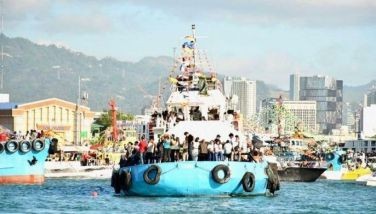Mosaic for peace

March 15, 2004 | 12:00am
Towards the end of last week I found myself reluctantly going to a conference at the Hyatt Regency as a UNESCO National Commission representative. My hesitancy stems from a preconceived notion about the subject matter of the conference which I thought was so academic, broad and utopian not only in this strife-torn world of ours but more specifically in my profession as a lawyer where I am constantly exposed to a predominantly adversarial environment. My only concept of real "Peace", which is the main conference theme, was limited to that peace of the grave at the cessation of earthly existence.
"A Mosaic for Peace" was really the complete talking point of the conference and the word "mosaic" attracted me much more. I thought that it is the term which would make the conference more colorful, interesting and challenging. It should really be if we literally take the meaning of the word "mosaic" as the "setting into a surface, small pieces of stone, glass or wood of different colors to form a picture or design". And the conference indeed was a mosaic of beautiful and friendly people from America, Europe, Asia Australia (New Zealand) and Africa with the Philippines being amply represented by Filipinos of different cultures particularly from Mindanao. This international conference was organized by the International Association of University Presidents (IAUP)/United Nations Commission on Disarmament Education, Conflict Resolution and Peace chaired by Sister Francesca Onley who is also the President of Holy Family University, U.S.A. and the De La Salle University, Manila, Philippines with its interim President, Dr. Carmelita I. Quebengco.
The Conference intended to bring together university, media, business and political leaders to form that mosaic design for the goal of world peace. Unfortunately, none of the business and political leaders especially from the Philippines came. And the sole Philippine media representative who had a role in one of the sessions failed to arrive. This is a pity and truly regrettable not only because the conference was held here but more importantly because our leaders especially our politicians wasted a golden opportunity to pick up valuable insights of great help in solving the peace and order problems in our own backyard. Those who came were mostly from the academe, notably University professors and the ubiquitous nuns or sisters who are always at the vanguard of any peace movement or rally. Special mention should be made of Sister Josefina G. Nepomuceno, President of St. Scholatica’s College a panelist on the "issues and challenges in peace" who talked about initiatives of ordinary citizens and their persistence, patience, courage and ability to withstand adverse reactions.
In one and a half days of sessions and dialogue using the language of the heart, the conference has succeeded in proving that peace after all is not an unreachable star. The session started with the presentation of an overview of the peace situation in the world by Dr. Julio C. Teehankee, Chair of the Political Science Department, DLSU. Then Dr. Kate Dewes, Vice President of International Peace Bureau, New Zealand, expertly demonstrated that the issues and challenges in peace can be overcome by "weaving webs of peace" simply because, "when the spiders unite they can tie down a lion" Trudy Rubin, Foreign Affairs Columnist of the Philadelphia Inquirer told the participants that media’s role as harbingers of peace is to accurately report "what’s happening on the ground" for people to determine whether war is necessary. Special sessions about research on conflict and conflict resolution followed with Dr. Madeleine Sta. Maria of DLSU presenting the research agenda for peace and conflict resolution; Dr. Johann Kirsten of Northwest University of South Africa showing the dimensions of change in Africa; Dr. Steve Wright of the Leeds Metropolitan University, UK assessing the next generation invisible, incapacitating and paralyzing technologies that are non-lethal but still violent; Sister Mary Soledad L.Perpinan, Secretary General of the Asia Pacific Peace Research Association introducing several alternatives to violence; and Dr. Rizal Buendia of DLSU explaining how we could learn from the peace process in Mindanao and Aceh. Dr. Thomas C. Daffern. Director, Int’l Inst. For Peace and Global Philosophy, UK then proposed an Education Aid by Business to assist in gathering the "scattered fragments of brokenness with which our world is littered" caused by so many "isms" from nationalism to egoism. Finally, our own Dr. Ester A. Garcia, former chair of CHED and UNESCO Commissioner, aptly concluded that "since war begins in the minds of men it is in the minds of men that defenses of peace must be constructed" as she presented the peace initiatives in higher education.
Our political leaders would surely have learned a most important part of good governance if they attended the conference. And media people too would be writing more about the stories of peace making, the good news that are sorely missing in all media of communication, if they only realized that they are one of the primary victims of violence.
E-mail: [email protected]
"A Mosaic for Peace" was really the complete talking point of the conference and the word "mosaic" attracted me much more. I thought that it is the term which would make the conference more colorful, interesting and challenging. It should really be if we literally take the meaning of the word "mosaic" as the "setting into a surface, small pieces of stone, glass or wood of different colors to form a picture or design". And the conference indeed was a mosaic of beautiful and friendly people from America, Europe, Asia Australia (New Zealand) and Africa with the Philippines being amply represented by Filipinos of different cultures particularly from Mindanao. This international conference was organized by the International Association of University Presidents (IAUP)/United Nations Commission on Disarmament Education, Conflict Resolution and Peace chaired by Sister Francesca Onley who is also the President of Holy Family University, U.S.A. and the De La Salle University, Manila, Philippines with its interim President, Dr. Carmelita I. Quebengco.
The Conference intended to bring together university, media, business and political leaders to form that mosaic design for the goal of world peace. Unfortunately, none of the business and political leaders especially from the Philippines came. And the sole Philippine media representative who had a role in one of the sessions failed to arrive. This is a pity and truly regrettable not only because the conference was held here but more importantly because our leaders especially our politicians wasted a golden opportunity to pick up valuable insights of great help in solving the peace and order problems in our own backyard. Those who came were mostly from the academe, notably University professors and the ubiquitous nuns or sisters who are always at the vanguard of any peace movement or rally. Special mention should be made of Sister Josefina G. Nepomuceno, President of St. Scholatica’s College a panelist on the "issues and challenges in peace" who talked about initiatives of ordinary citizens and their persistence, patience, courage and ability to withstand adverse reactions.
In one and a half days of sessions and dialogue using the language of the heart, the conference has succeeded in proving that peace after all is not an unreachable star. The session started with the presentation of an overview of the peace situation in the world by Dr. Julio C. Teehankee, Chair of the Political Science Department, DLSU. Then Dr. Kate Dewes, Vice President of International Peace Bureau, New Zealand, expertly demonstrated that the issues and challenges in peace can be overcome by "weaving webs of peace" simply because, "when the spiders unite they can tie down a lion" Trudy Rubin, Foreign Affairs Columnist of the Philadelphia Inquirer told the participants that media’s role as harbingers of peace is to accurately report "what’s happening on the ground" for people to determine whether war is necessary. Special sessions about research on conflict and conflict resolution followed with Dr. Madeleine Sta. Maria of DLSU presenting the research agenda for peace and conflict resolution; Dr. Johann Kirsten of Northwest University of South Africa showing the dimensions of change in Africa; Dr. Steve Wright of the Leeds Metropolitan University, UK assessing the next generation invisible, incapacitating and paralyzing technologies that are non-lethal but still violent; Sister Mary Soledad L.Perpinan, Secretary General of the Asia Pacific Peace Research Association introducing several alternatives to violence; and Dr. Rizal Buendia of DLSU explaining how we could learn from the peace process in Mindanao and Aceh. Dr. Thomas C. Daffern. Director, Int’l Inst. For Peace and Global Philosophy, UK then proposed an Education Aid by Business to assist in gathering the "scattered fragments of brokenness with which our world is littered" caused by so many "isms" from nationalism to egoism. Finally, our own Dr. Ester A. Garcia, former chair of CHED and UNESCO Commissioner, aptly concluded that "since war begins in the minds of men it is in the minds of men that defenses of peace must be constructed" as she presented the peace initiatives in higher education.
Our political leaders would surely have learned a most important part of good governance if they attended the conference. And media people too would be writing more about the stories of peace making, the good news that are sorely missing in all media of communication, if they only realized that they are one of the primary victims of violence.
E-mail: [email protected]
BrandSpace Articles
<
>
- Latest
- Trending
Trending
Latest
Trending
Recommended

January 21, 2025 - 12:00am

January 18, 2025 - 12:00am
























